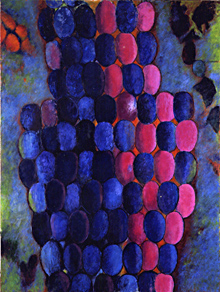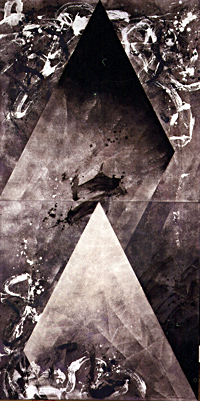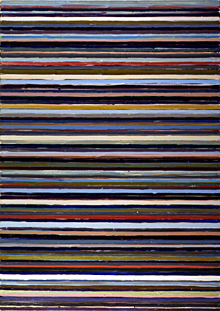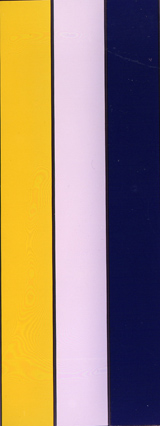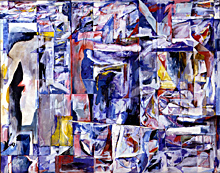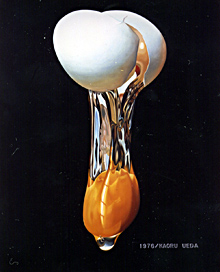4e
絵画回帰
Return to Paintings
【本文確定】
1970年代中頃から1980年代初頭の美術界における「絵画への回帰」には、およそ三つの意味が含まれます。
一つ目は還元主義の作家の変質に伴う絵画や彫刻の形式への回帰です。1970年代前半の李禹煥や吉田克朗の軌跡は絵画回帰と呼べるものであり、小清水漸や関根伸夫の軌跡は彫刻回帰と呼べます。ここで、絵画や彫刻という形式は1970年前後には保守反動に見えていたことを鑑みるならば、彼らは「新古典主義」の役回りを果たしたともいえます*4e1。やや遅れて美共闘、そしてポスト概念派やポストもの派の作家たちの一部が絵画や彫刻形式へと回帰しました。田窪恭治は装飾的な彫刻を作り始め、清水誠一や高見澤文雄は色彩的な絵画を描き始めました。ハイレッド・センターの元メンバー、中西夏之も、この時代に画家としての新展開を見せました。
二つ目は、潜在する絵画形式の渇望が多様性の一翼として顕れた動向です。システミック・ペインティングから出発した辰野登恵子や中上清、諏訪直樹らが注目されました。また、「描くことの復権」を唱えた宇佐美圭司や、一時期流行したスーパーリアリズムの上田薫らも挙げておきます*4e2。ちなみにこの時代には、1950年代から絵画自体を問うような制作をしてきた山田正亮や桑山忠明も脚光を浴び、これには藤枝晃雄の批評活動が一役買いました。その内容は絵画形式への還元を主張するアメリカ型のフォーマリズムであり、絵画や彫刻という形式さえ捨てられるとした「人間と物質」展型の還元主義ではありませんでした*4e3。
一つ目と二つ目には共通して、何らかのシステムの実践として制作される傾向がありました。実作面では李禹煥の「点より」「線より」が先鞭をつけましたが、理論面では美共闘によるプラークシス(実践)の称揚が背景にあったかもしれません。もっとも、米国のミニマル・ペインティングも意識されたかもしれません。
そして三つ目は前二者とは異質の大きなうねりで、1980年代初頭の西洋の「バッド」な具象絵画動向、いわゆる「新表現主義」に呼応した動きです。前二者に残存していた禁欲がいっさい解かれ、「絵画の復権」と呼ばれました。これは次章で扱います。
There are three meanings inherent in "return to paintings" in the art scene between the middle of 1970s and beginning of 1980s.
First is the return to paintings and sculptures due to changes in tendencies of the reductionist artists. The path that Lee U-Fan and Yoshida Katsuro took can be called return to paintings and the paths that Koshimizu Susumu and Sekine Nobuo took can be called return to sculptures. Because paintings and sculptures seemed like a conservative reaction around the 1970s, it can be said that they have taken on the role of the Neo-Classicists*4e1. Some of the artists from Bikyoto, Post-conceptualists and Post Mono-ha followed the same path later and went back to doing paintings and sculptures. Takubo Kyoji started to do decorative sculptures, while Shimizu Seiichi and Takamizawa Fumio came to doing colorful paintings. Former Hi-red Center member Nakanishi Natsuyuki also moved on to becoming a painter during this time.
Second is the trend in which the latent longing for paintings played a part in creating diversity. Artists such as Tatsuno Toeko, who started out with systemic paintings, as well as Nakagami Kiyoshi and Suwa Naoki gained attention. Usami Keiji, who advocated "reinstatement of the act of painting," as well as Ueda Kaoru, who is associated with the once popular Super-Realism, will also be mentioned here*4e2. During this time, Yamada Masaaki and Kuwayama Tadaaki, who created works which seemed to question paintings themselves since the 1950s, also gained attention, helped by the criticism of Fujieda Akio. The content was an American style formalism which argued for the return to paintings and not reductionism in the style of "Between Man and Matter" exhibition which claimed that even paintings and sculptures can be renounced.
The first and second both had commonality in which there was a tendency to produce works as an engagement of some type of system. In the actual works, Lee's "From Point" and "From Line" took the lead, but in the theoretical sense, there was probably a praise for Bikyoto's praxis (activity) in the background. There might even have been an awareness of the American minimalist paintings.
The third is a big undulation different in nature from the preceding two, which was a trend in "bad" Western representational paintings of the early 1980s, a movement in response to "Neo-Expressionism." The asceticism which remained in the preceding two were completely eliminated, and was called "reinstatement of paintings." This subject will be touched upon in the next chapter.
